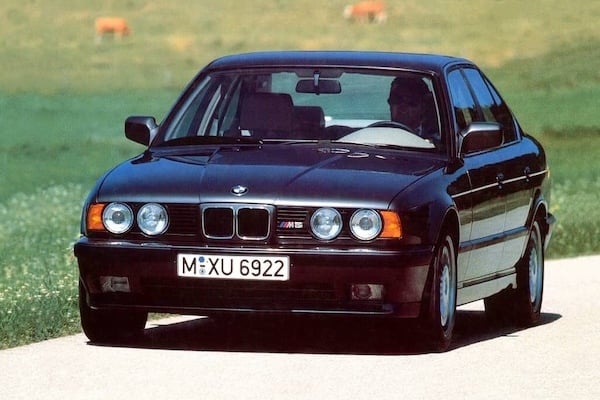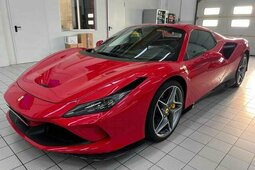While many tales of supercars resemble heroic sagas of world-saving feats, the journey of the BMW M1 stands out for its challenging beginnings and the near possibility of never coming to fruition.
Recognized as one of the most distinctive models in BMW's history, the M1 had a limited production run of 453 cars between 1978 and 1981. Out of these, 399 were street-legal, while the remaining were designed for racing. The rarity of the BMW M1 has led to its collectable status. Acquiring one is challenging due to its limited availability, with the average price ranging from USD 500,000 to 600,000.
Prominent names couldn't ensure triumph
Ironically, what has now considered an exclusive BMW masterpiece and Germany's first supercar was once a significant source of concern for the entire Bavarian company. The journey began in 1972 with the creation of the BMW Turbo Concept. BMW then established a motorsport division, and the M1, codenamed E26, became its inaugural project.
BMW made no secret that the primary goal of the M1 project was to homologate the car for racing and compete with Porsche, particularly at Le Mans. However, according to the FIA regulations in the mid-1970s, they needed to produce at least 400 street-legal M1s to participate in Group 4 races alongside other manufacturers. BMW anticipated achieving this within a couple of years and enlisted renowned names for the development: Dallara crafted the chassis, Italian legend Giorgetto Giugiaro designed the wedge shape, and Lamborghini was responsible for engineering details and producing the necessary 400 cars. The Germans were only tasked with testing and market preparation.
Although the start was promising, not all links functioned successfully. Lamborghini, which was having significant financial problems at the time, failed to deliver and kept putting off the start of production. They only managed to produce seven prototypes by the spring of 1978, so BMW was finally forced to terminate the contract with the Italians at the most important moment and take production into their own hands, even though, from the beginning, they did not want to allocate their production capacity for such a small quantity.
Despite the various disturbances and balancing between “to be or not to be”, the M1 – the long-awaited cocktail of German and Italian ingredients – saw the light of day. It was delivered to the first buyer in February 1979. What made the BMW M1 unique? This is a rare case, but from the beginning, this model was designed as a race car, which is reflected in almost every detail. For example, the suspension was designed so that it could be used with engines from 277 to 950 PS without major changes.
Among the options under consideration for the engine were both 8- and 12-cylinder motors. Still, it was ultimately decided for economic reasons to build a new 6-cylinder engine, thus giving birth to the M88. This had three versions, and the heart of the street-legal M1 model beat with impressive power. The 3.5-litre engine generated 277 PS and 330 Nm (the Procar race version had 470 PS and 390 Nm). Its 5-speed manual ZF transmission transmitted power to the rear wheels. The M1 had a top speed of 260 km/h, and could accelerate to 100 km/h in just 5.6 seconds. That was really a lot by 1980s standards, making it one of the most powerful choices among naturally aspirated six-cylinder engines. A modified version of the M88 was later installed in both the BMW M635 CSi and the first M5 (E28).
Since glass fibre was used to produce the body, the car was not heavy and stood out for its excellent handling. Despite its sporty nature, it was actually a comfortable car suitable for daily driving. BMW initially hoped that Lotus, Ferrari and Aston Martin fans would take a liking to the M1. However, the long wait annoyed potential buyers, and even though the BMW M1 was not considered a fancy car, it was still far from cheap – in Germany, it cost almost 100,000 Deutschmarks or about 55,000 USD – and this did not contribute to its popularity either.
No resounding victories
While the Germans were struggling with the development of the M1, FIA rules changed and homologated cars like the M1 were no longer allowed to participate in group 4 classification races. However, BMW did not give up and started holding Procar races.
The unique championship, organized with Formula One, saw the top five drivers from the qualifying race take the wheel of an M1, competing against 15 private drivers in M1s over a 100 km distance. This continued for a few years, with Niki Lauda winning the 1979 championship and Nelson Piquet taking the title the following year. However, many M1 sports cars faced engine issues, leading to unfavourable reviews and preventing the project from achieving its intended success.
In 1979, BMW also appeared at the 24 Hours of Le Mans with an M1 which stood out from all the rest with its colourful body painted by artist Andy Warhol. Its 6th place in the overall standings was its best achievement – up until 1986 a few dozen other M1s could be seen on the Le Mans track, but due to fierce competition and poor reliability, this model never did bring any resounding victories.
With over 50 Procar versions produced, this model is even more exceptional than the street-legal M1 and commands higher auction values. For example, a 1979 BMW M1 Pro-car 9430-1053 fetched USD 854,000 in 2011. The manufacturers themselves preserved many Procar vehicles, and in 2016, the Legends Parade at the Austrian F1 Grand Prix showcased former racing stars in BMW M1 Procars. A total of 14 cars took to the track, driven by renowned personalities such as Niki Lauda, Gerhard Berger, Dieter Quester, Jochen Mass, and Jos Verstappen.
A Pioneer Legend: The M1's Timeless Legacy
The complicated and expensive production process and partners who didn’t hold up to their agreements resulted in the fate of this model being decided even before it came out, and the manufacturers, as per speculation, only suffering losses. With hopes for the M1 left unjustified, BMW decreased the motorsport division’s budget by 75 per cent and the last BMW M1 was assembled in February 1981.
Now it is obvious that the pioneer of the M Series was a car ahead of its time, and one can only wonder what the BMW brand would have become had the M1 project been more successful. It remains the only mid-engine model in the history of BMW. To mark the 30th anniversary of this exceptional piece, the Bavarians demonstrated the BMW M1 Hommage Concept, also designed by Giugiaro, in 2008. Even though this model never became a production vehicle, some of the highlights of the vision were nevertheless adopted by the hybrid i8, which was launched in 2014 and is considered an indirect successor of the BMW M1.
The BMW M1: A Racing Car Unable to Compete on the Track
---
Discover your dream car within our Car Categories, or explore our Classic Passion Shop to uncover thrilling items from our associates!




















